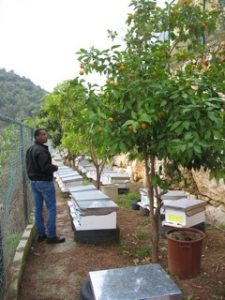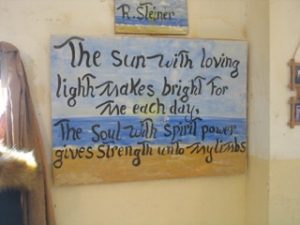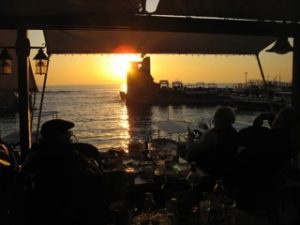This blog is about my visit to Lebanon in January and some ideas that it prompted in me. My return journey was rather eventful, since my flight via Istanbul was cancelled because of heavy snow. I managed to get a flight the next day to Athens, where it was also snowing heavily and I was lucky to get a flight to Berlin – not exactly my home airport, which is Hamburg. Somehow the combination of the cold and wet and lack of sleep left me with a latent weakness which finally broke out a bad dose of flu, from which I am just recovering – which is why I haven’t posted this blog earlier.
Arrival
In the first week in January I visited Lebanon for the first time. I was cold, wet and it even snowed but I was cheered by the warmth of the people I met. As we landed the view from the plane showed a city packed tightly onto the steep slopes of the mountains tumbling down into the wide bay of Beirut. Above the city through the low cloud could be seen the snow topped peaks of Mount Lebanon. Later being driven through the narrow streets between the city’s modern high rise buildings, I was reminded of Naples, not least by the ancient ruins of Roman baths and temples. The older Quarters of the city have streets and houses with cellars that go back to Phoenician times and buildings with a wide range of architectural styles that reveal the many influences – Roman, Early Christian, Islam, Crusader, Ottoman, French and the many hybrids that have grown there. Lebanon has always been a trading land since Phoenician times, open to the world through its many harbours Dor Acre, Tyre, Sidon, Beirut, Canaan, Byblos, Tripoli. Lebanon has been ruled by the Assyrians, Babylonians, Persians, Greeks, Roman, Arabs, Turks, French and Syrians yet has a distinct cultural identity. There three times more Lebanese living outside of Lebanon than inside and the exile communities around the world.
This was the second station in my project (previously I visited Kyrgyzstan) to look at how the ideas of Waldorf education can enable young people with disabilities to feel included in social and community life and lead a more rewarding life. The project is on behalf of the Friends of Waldorf Education (Freunde der Erziehungskunst Rudolf Steiners) and is funded by the German Ministry of Economic Cooperation and Development.
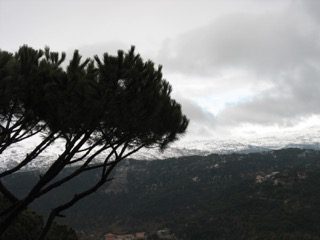
Lebanese background
The Step Together Association FiSTA- Beirut was born as a project in 1974, just before the civil war broke out in Lebanon (1995-1990), and has continued to grow in spite of years of warfare, the Israeli occupation of Southern Lebanon (up unto 2000), the Syrian occupation (until 2005), the Cedar Revolution and Civil War of 2006 between Hezbollah paramilitaries and the Israeli military and the fighting in 2007 between the Lebanese Army and Fatah-al-Islam in the Palestinian Refugee Camps. Since the outbreak of the Syrian civil war in 2012, over two million refugees have taken up residence in Lebanon, adding to the existing population of around 5 million (including around half a million Palestinian refugees).
Lebanon is an Arab country with 54% Muslims (including equal numbers of Sunni and Shi’a Muslims), 41% Christians (including Maronite Catholics, Greek Orthodox, Melkite Catholics and other denominations) and Druze, who make up about 5% of the population (these figures are approximate because no census has been taken since the 1930s because it is too politically sensitive). I had the interesting experience of standing at the back of crowded Romanesque church – St John-Mark in Byblos – dating back to the Crusades- celebrating a Catholic Mass in Arabic. This brief cultural and historical information gives some idea of the complexity of Lebanese society. Beirut is a bustling cosmopolitan city of around 2 million people. As people regularly tell you, you can go skiing on Mount Lebanon and then water skiing in the Mediterranean on the same day (the same is said about Los Angeles, which even adds in the option of visiting the desert- though the same day offer does not allow for traffic).
Step together
Step Together was founded by a young medical doctor, now known as Dr Wali (originally Waltroud) Merhej, who originally came from Austria. Initially it was established as a kindergarten and diagnostic centre for children with special needs. Today it cares for over 200 people with disabilities and special needs from kindergarten to adulthood. At the Riverside campus there is a kindergarten, a school, a pre-vocational training, a vocation section with workshops, a therapy centre and residential section for about a dozen young people. I stayed within the residential section. Off-site there are other workshops. The school is a beautiful site, a steep valley not far from the city centre, with the ruins of a Roman aqueduct nearby. I recommend readers to visit the Step Together website www.steptogetherlb.org.
I was impressed by many things in Step Together. I first met some of the staff in residential, many of whom are not Lebanese, but come from Ethiopia and other African countries. This reflects the general situation that many domestic staff, drivers, housekeepers, cooks, gardeners are migrants, who send money home to support their families. Abdul Hamid, who showed me around and generally looked after me, has been at Step Together for 15 years. He is building a house back in Ethiopia for his wife and two children, whom he sees once a year. This multi-cultural group formed a friendly and welcoming team, who included me in their late night meals and birthday celebrations.

Equally impressive is the dedicated team of young women (and one man, the operational director Shadi Zakhour, a friendly American with Lebanese roots) around director Dr Reem Mouawad. Each of the coordinators is responsible for an area of the institution, which means supervising the other co-workers and the pedagogical and therapeutic work. Each department has an up-to-date handbook with all the relevant information, documentation, individual development plans for each student or workshop worker, contact with parents and external authorities and notes on the regular case studies are carried out. Alongside this, an ongoing professional development cum training is run, partly using visitors from abroad from the European special needs and therapeutic movement.
I met with each of the coordinators, who showed me how their work is organized around the pupils’ needs and the further development of the staff. We discussed the challenges of the work- not least the difficulty of finding qualified people willing to work in a challenging profession with relatively low financial rewards. Many are women, who either move on to better paid jobs or family duties. Those who stay are inspired by and committed to the work- like the coordinators themselves. There are wealthy people in the Middle East who can afford to hire private teachers or therapists for their children and thus the temptations are great for those who have become qualified through their work at Step Together.
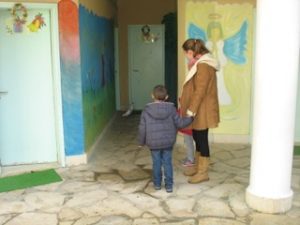
Whilst Lebanon has a policy of integration and care for the disabled, the funding bears no relation to what is needed and the bureaucracy painfully slow to pay up. Thus Step Together is dependent on well-off parents paying and on the substantial contributions of sponsors and donors and much of the director’s work involves cultivating this vital network – the Committee of well-off women who support the school both materially but also through their many contacts to sponsors or officials. In a small country like Lebanon, it is often a question of who knows who. Officially, the status of people with disabilities is clearly established and is supervised by the Ministry. However, quite apart from the enormous burdens Lebanon is carrying financially and politically, which make infrastructure and social care difficult, traditional attitudes towards disabled people make the situation hard. Though both the Koran and the Bible teach that the needy, sick and disabled should be cared for and respected, in practice having a disabled child is considered a shame on the family in most communities. I was curious about this and did quite a lot of literature searches – this a blog, so I won’t go into detail with references- but both the academic literature and the UNESCO, United Nations, official Ministry and NGO literature all tell a fairly similar story for the Middle East in General. The situation in Lebanon is perhaps less extreme because of the relatively large number of educated and cosmopolitan people, but it is still difficult. Girls are often kept at home and not educated since they will anyway not be married off and it would be a wasted investment. If possible boys are given whatever education money can buy in the hope that they eventually become ‘normal’. Thus parental expectations are high that boys can somehow be ‘cured’.
Destiny learning
Finally, I want to mention Dr Reem Mouawad, who is the director. Reem, who is also on the International Council for Curative Education and Social Therapy at the Goetheanum, brings a wealth of experience to her work, not least her recent academic work- she completed a PhD at Aberdeen University/American University Beirut. Her theme was destiny learning based on Steiner’s seven life-processes. She worked with some of her team at Step Together and they explored issues of self-development or using the life processes idea as a heuristic to identify what she calls ‘destiny learning’ (borrowing and extending van Houten’s term). Destiny learning involves the person generating awareness of her identity, strengths and weaknesses- coming into presence- in relation to that of the community. Over a period of time the participants in the study developed their awareness of their destiny through a series of stages that correspond to the stages of the life processes. This is a very innovative approach to teacher professional development we could all learn from.
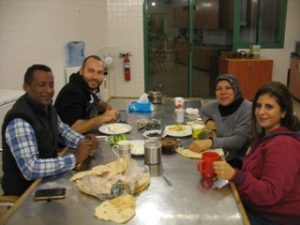
The seven life processes has been a theme I have worked on for years, notably in the relationship to learning processes going back to some article that Dr James Dyson and I published in the Paideia Journal (sadly no longer available). I will publish a paper on learning processes which I wrote some time ago, as soon as I get a chance. Reem has applied the notion of the life processes to biographical work, drawing on ideas developed by Coen van Houten, to the question of professional teacher development- another of my themes. So I was very grateful that Reem let me have a copy of her PhD.
FiSTA North Lebanon
Whilst I was in Lebanon I was also invited to visit the FiSTA North Lebanon project in Tripoli to the North of Mount Lebanon, which is also trying to work with the ideas of Waldorf education. Though not part of my evaluation, it was nevertheless interesting to see how other projects are working along similar lines. In Tripoli there are many NGOs working with the refugees (the Syrian border is very close), though the plight of refugees with disabilities has not been recognized. I was told that the percentage of children born with disabilities due to genetic factors in rural areas of Syrian is high because of local marriage traditions, which allows quite close relatives to marry.
The school I visited in the city of Tripoli was located in an apartment block with no outdoor space at all for the children to play, which in summer must be challenging. I was curious to see that the children were being taught English. The reasons I was given were that written English is earlier for them to learn than written Arabic and that it was necessary for the Lebanese curriculum. When I pressed on this, it transpires that the parents expect their children to pass the state exams later and this involves having some English and is therefore a question of social status rather than an educational requirement. This an aspect of Lebanon’s colonial heritage (French is taught in many normal schools as the language of instruction).
I politely questioned (off the record, as it were) whether this is really what children with severe learning difficulties, physical and mental disabilities need, especially who in many cases are struggling with their mother tongue. No it obviously isn’t, though if the children are given the opportunity to learn English or French in a conversational way, they probably could learn it, but they were being taught in fairly literacy based method. No, they are being taught this because the parents expect it. And because they hope that by paying to send their child to this school, this will somehow enable them to overcome their difficulties and become ’normal’. For the children this another burden on their already weak identities.
I do not want to criticize the work of the teachers in the FiSTA North school- they are doing invaluable work! What they lack is a holistic pedagogical concept that addresses the real needs of the children. Where would they get such a concept from? The teachers, even if they have studied at the university, have themselves been socialized into a very academic (French first, American second) understanding of learning.
What inspired me most was my visit to the workshops in Tripoli, in an old traditional merchant’s warehouse on the beach. Here the team are working with young designers to make modern products that can be more easily marketed and that can be made the disabled people. It was here that I felt a real connection to the project. I met with the director and coordinator of FiSTA North and they assured me that they were willing to work with Waldorf, if a way could be found to do this in a way that was compatible to their current approach. I agreed to do what I could to facilitate this. FiSTA North clearly states in the flyers I saw (and on their website) that they use the Rudolf Steiner Education Program, and this statement is accompanied by two quotes from Steiner. In the school this approach was not very visible. The coordinator I spoke to was at pains to explain that they had tried to attend the Waldorf training programme offered in Beirut at FiSTA Beirut and had had various Waldorf ‘experts’ to visit. There were travel issues and many teachers could not take time off to travel to Beirut. I had the distinct impression, however, that they couldn’t make a lot of sense of the approach they were offered. This is a situation I can sympathize with.
Waldorf basic
There are difficulties, however I am convinced that there is also a fundamental wish both in Tripoli and in Beirut to work together. Considering how best to approach this, prompted the following thoughts, and linked to some ideas I have had for many years, prompted by my experience of Waldorf teacher education in many of the countries I have visited. On the one hand Waldorf is not a series of recipes that can be applied without a full understanding of the whole theory of the developing human being from the anthroposophical perspective. On the other hand, if a full time study of Steiner’s works and anthroposophy is not possible (because no one can lead it and it’s hard without guidance, especially in a foreign language, and because there is not enough time), then there are number of practical things one can do with children that make a huge difference, even if you don’t yet grasp all the theory. For this reason, I support the teacher training programme in Bangalore, which is not led by an experienced Waldorf teacher (though Manivan who runs the course has acquired deep insights and communicates these in his own ways). On several occasions I have promoted ideas about ‘Waldorf basic’, referring to ways of organizing early years and primary school education following Waldorf principles without having to be Waldorf schools. Sometimes this has got me in trouble with representatives of ‘Waldorf mainstream’. Though a central part of my work is with teacher students learning to understand Steiner’s lectures to the first Waldorf teachers ‘Foundations of Human Experience’ (in Kiel and in Stuttgart) and I see this as essential, I also think that a Learning on the job is possible- not least if the luxury of a full time seminar is not possible.
While special education is not my field, I think that there is a lot of cross-over and many of the ideas that I have developed for Waldorf basics might be of great help to projects like that in North Lebanon. I can quote Michael Luxford from Camphill in Northern England, whose children I taught at the York Steiner School many years ago, who wrote, “One of the main tasks of curative education is to get away from solely assessing the capacities of the child and to add to it the fostering of the unique qualities possessed by the child and young person” (1994, 17). In his introduction to special education, he defines three basic necessities if this education is to be effective:
1. Knowledge of the human being.
2. Observation of children.
3. Understanding leading to a therapeutic approach.
On the basis of well-established practice in existing schools, one could put together some basic activities that could be slipped into or over the existing teaching arrangements (e.g. free play and sense development, use of stories and puppets). This could be accompanied by on-going taught courses with material to read.
I can envisage a series of units (i.e. teaching and material) on basic themes such as:
• The idea of human development and the notions of abilities and disabilities, ‘normal’ and ‘abnormal’ as movement along a spectrum and the question of recognizing and fostering identity and individuality.
• Working with the whole human being, body, soul and spirit.
• Salutogenesis as the basis for well-being and health.
• The importance of rhythm.
• The importance of play.
• The importance of working with the senses and movement.
• The importance of narrative.
• Form drawing.
• Working with the arts and movement.
• Handicrafts.
• Teacher professional development.
• Observation of pupils.
Once I have completed my evaluation project I will return to this field and will take into the knowledge of some old friends who have been working with children with special needs for many years in Waldorf contexts.
Best wishes Martyn



